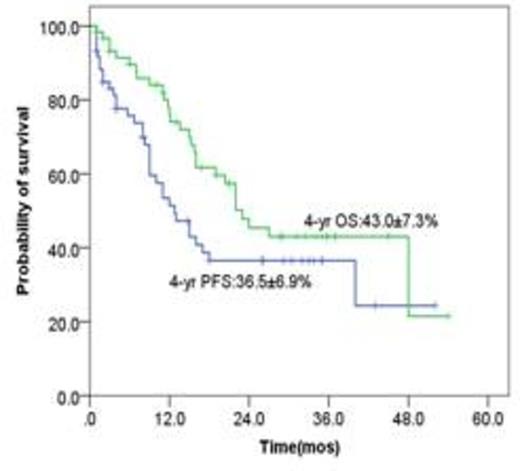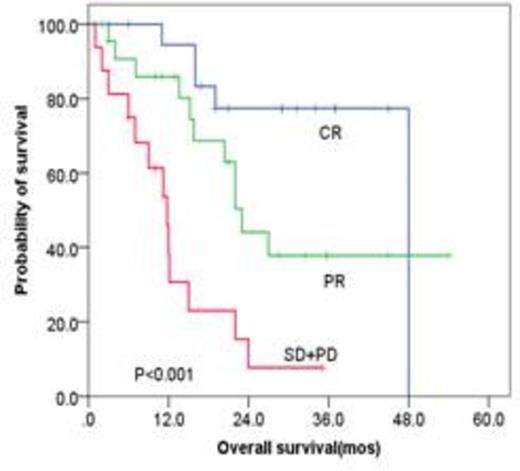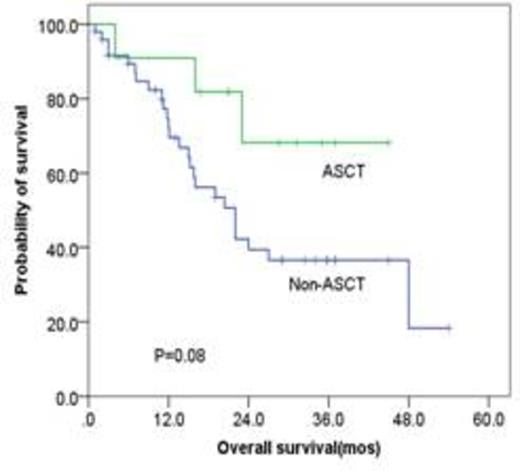Abstract
Purpose
Extranodal natural killer/T-cell lymphoma (ENKTL) is an aggressive form of non-Hodgkin's lymphoma. The prognosis for patients with advanced stages or relapsed/ refractory ENKTL is extremely poor. Optimal combined chemotherapy remain to be defined. Therefore, the purpose of this study is to evaluate efficacy and safety of P-GEMOX (Pegaspargase, Gemcitabine and Oxaliplatin) in patients with newly diagnosed stage III/IV or relapsed/refractory ENKTL.
Patients and methods
We retrospectively analyzed the effectiveness and toxicity of P-GEMOX in 60 patients with newly diagnosed stage III/IV and relapsed/refractory ENKTL between February 2008 and August 2014. The P-GEMOX dosage was as follows: Gemcitabine 1000 mg/m2 iv d1,d8; Oxaliplatin 100 mg/m2; d 1, Pegaspargase 2000 U/m2 im, two different sites. The regimen was repeated every three weeks for a maximum six cycles. Patients underwent autologous hematopoietic stem cell transplantation (ASCT) as consolidation if they achieved CR.
Results
57 patients were available for evaluation of response. The objective response, complete remission(CR), of whole cohort were 73.7% (42/57), 36.8% (21/57), respectively. It can be easily administered in out-patients clinic. The median follow-up was 29.1 (range, 2.4¨C54.2 months). Median OS and PFS was 23.0 months (95% confidence interval [CI], 16.441-29.559) and 12.8 months(95% confidence interval [CI], 8.109-17.491), respectively. The 4-year OS and PFS rate was 43.0¡À7.3% and 36.5¡À6.9%, respectively (Figure1). There was no difference between newly diagnosed stage III/IV and relapsed/refractory in OS and PFS. The long term survival CR responders were superior to patients with other response, and there was significant difference between the three group(Figure 2, P<0.001). Eleven patients accepted ASCT after achievement of CR, 3-year OS rate were better than other patients( 68.2% vs. 36.6%£¬P=0.08, Figure 3). Toxicities (>50%): neutropenia (85.0%), thrombocytopenia (72.0%), hypoproteinemia (86.7%), and anorexia (63.3%). In addition, hypofibrinogenemia was 46.7%. The most common grade III/IV toxicities (>10%) were granulocytosis (31.6%), thrombocytopenia (26.67%) and hypoproteinemia (13.3%)(Table 1). Intracranial bleeding occurred in one patient during the first cycle with discontinuation of pegaspargase in the consecutive cycles. No treatment related death confirmed.
Conclusion
The P-GEMOX regimen is a safe and effective combination for newly diagnosed advanced and relapsed/refractory ENKTL. Promising long term outcome can be expected by addition of ASCT consolidation after response to induction chemotherapy. In comparison to other combined regimen in literatures, P-GEMOX is effective with less toxic, simplified and high cost-effective. Further clinical trials urgently needed.
Toxicities of whole cohort
| . | All cases (%) . | Grade 1/2 (%) . | Grade 3/4 (%) . |
|---|---|---|---|
| Toxicities | |||
| Neutropenia | 51(85.0) | 32(53.3) | 19(31.6) |
| Thrombocytopenia | 22(36.7) | 15(25.0) | 7(11.7) |
| Anemia | 43(71.6) | 18(66.7) | 3(5.0) |
| lymphocytoponia | 14(23.3) | 12(20.0) | 2(3.3) |
| AST/ALT elevated | 26(43.3) | 22(36.7) | 4(6.7) |
| Hypoproteinemia | 53(88.3) | 48(84.9) | 8(13.3) |
| Fbg decrease | 41(68.3) | 39(65.0) | 2(3.3) |
| APTT prolong | 16(26.7) | 16(26.7) | 0 |
| Hyperglycemia | 7(11.6) | 7(11.6) | 0 |
| Total bilirubin elevated | 9(15.0) | 9(15.0) | 0 |
| Nausea | 21(35.0) | 21(35.0) | 0 |
| Anorexia | 32 (53.3) | 32 (53.3) | 0 |
| Vomiting | 19(31.6) | 19(31.6) | 0 |
| Allergic reactions | 1(1.7) | 1(1.7) | 0 |
| herpes zoster | 3(5.0) | 3(5.0) | 0 |
| . | All cases (%) . | Grade 1/2 (%) . | Grade 3/4 (%) . |
|---|---|---|---|
| Toxicities | |||
| Neutropenia | 51(85.0) | 32(53.3) | 19(31.6) |
| Thrombocytopenia | 22(36.7) | 15(25.0) | 7(11.7) |
| Anemia | 43(71.6) | 18(66.7) | 3(5.0) |
| lymphocytoponia | 14(23.3) | 12(20.0) | 2(3.3) |
| AST/ALT elevated | 26(43.3) | 22(36.7) | 4(6.7) |
| Hypoproteinemia | 53(88.3) | 48(84.9) | 8(13.3) |
| Fbg decrease | 41(68.3) | 39(65.0) | 2(3.3) |
| APTT prolong | 16(26.7) | 16(26.7) | 0 |
| Hyperglycemia | 7(11.6) | 7(11.6) | 0 |
| Total bilirubin elevated | 9(15.0) | 9(15.0) | 0 |
| Nausea | 21(35.0) | 21(35.0) | 0 |
| Anorexia | 32 (53.3) | 32 (53.3) | 0 |
| Vomiting | 19(31.6) | 19(31.6) | 0 |
| Allergic reactions | 1(1.7) | 1(1.7) | 0 |
| herpes zoster | 3(5.0) | 3(5.0) | 0 |
4-year OS and PFS of whole patients
Survival of whole patients, based on response
OS: patients with ASCT vs. Non-ASCT
No relevant conflicts of interest to declare.
Author notes
Asterisk with author names denotes non-ASH members.




This feature is available to Subscribers Only
Sign In or Create an Account Close Modal